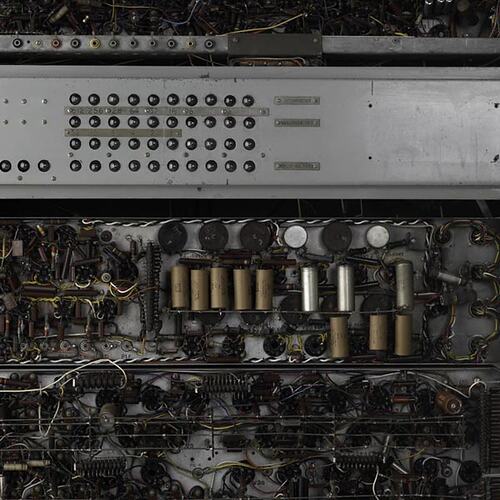Soon after its creation in 1870, the Industrial & Technological Museum began to conduct classes in telegraphy, to train young men and women for jobs in the rapidly expanding industry. Ever since, the presentation of contemporary and historical examples of communication technologies has been a priority of the museum.
Close relationships with government agencies, universities and local industries have resulted in the development of a collection that reflects many of the major changes in information and communication technology throughout the 20th century.
With key items such as the CSIRAC computer and Alexander Graham Bell's experimental telephone, this collection is of both national and international significance. It includes items of phonography, television, computing, radio, telephony, telegraphy, electronics, photography and cinematography.
Significant items
- CSIRAC (1949-64): the first automatic electronic stored-program computer in Australia and one of the first in the world. It is the only first-generation computer still in existence.
- Mainframe computers, including IBM CDC3200 (1960s), Cray Supercomputer X-MP (early 1980s).
- Microcomputers and microprocessor chips, from the 1970s to present.
- Noughts and Crosses machine: an early example of an interactive display using diodes, relays and uniselectors.
- Early calculating devices, from Napier's rods to arithmometers and totalisators.
- Domestic communication technologies: telephones, phonographs, radios, televisions, including items of considerable historic interest, including one of the first Edison phonographs in Australia.
- Pioneering items in the history of radio in Australia: Jenvey Coherer (1901), Max Howden receiver, Flying Doctor equipment, ABC station 3LO's Studio 303 (1939-86).
- 19th century telegraphic equipment and early telephonic equipment, including Alexander Graham Bell's experimental telephone equipment (1876), early Melbourne telephone exchange switchboard.
- Baird Mirror Television (1937), probably the first cathode-ray tube television in the Southern Hemisphere; experimental spinning disc television relics developed by Gil Miles in the 1920s.
- Fawkner Press, used to print the first newspaper in Victoria in 1838.
- Printing presses from the Victorian Government Printer, mid-19th century to the 1960s.
- Paris Universal Exposition, 1867, Reports of the United States Commissioners, Examination of the Telegraphic Apparatus and the Processes in Telegraphy by Samuel Morse. The title page carries the underlined handwritten inscription 'With the author's compliments', presumably in Morse's handwriting.
- Comprehensive set of technical and office items and images collected from the Melbourne Radio Coastal Station, (opened 1912, closed 2003), including an audio copy of the last official morse code radio transmission in Australia, sent 1 February 1999.
More Information
-
Keywords
information & exchange objects, Communications, communication systems, CSIRAC (Computer)
-
Localities
-
Authors
-
Article types
